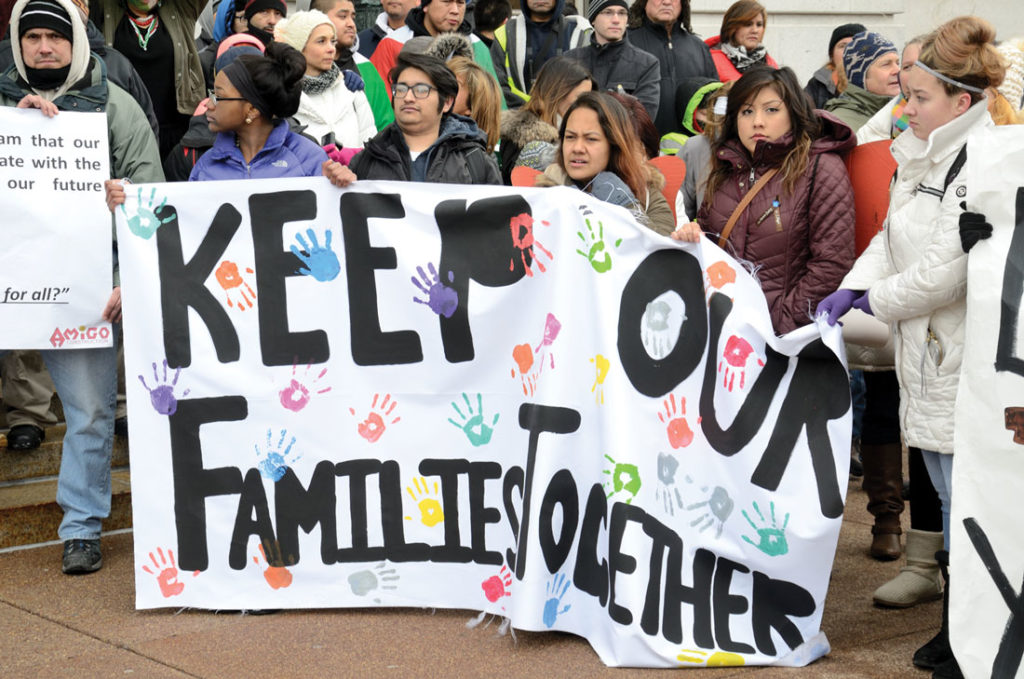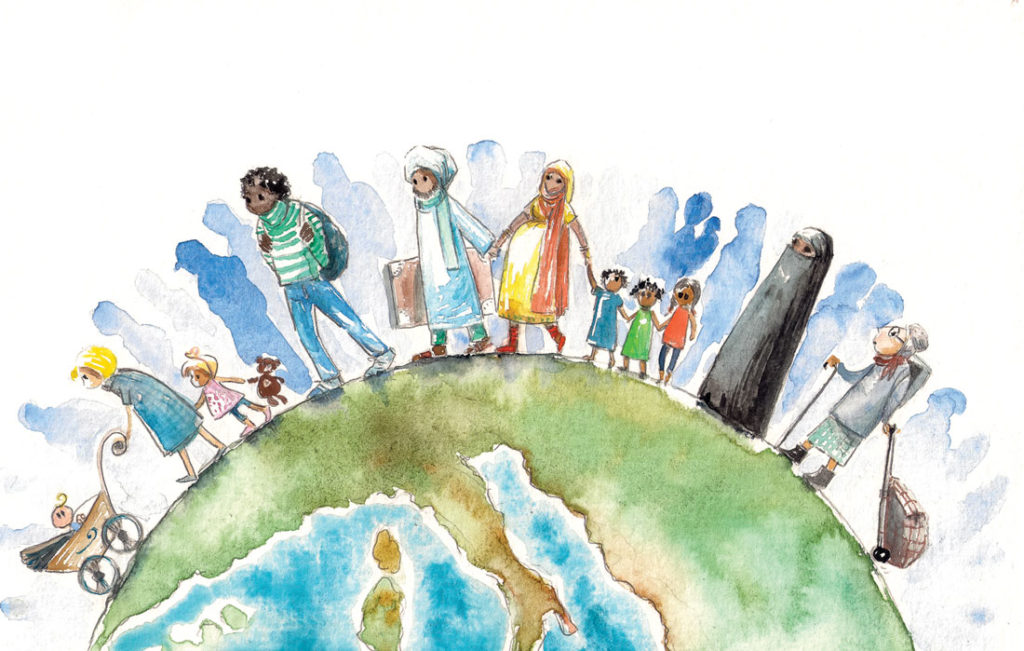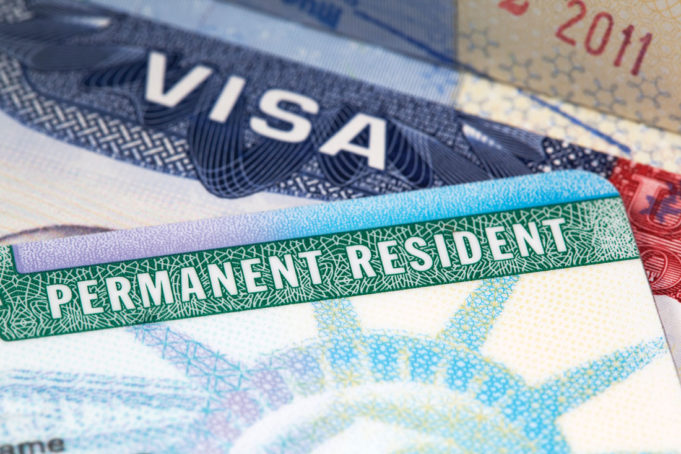Jaime is a hard-working twentysomething guy with a wife and a young son. He’s lived in Texas since he was 8, starting elementary school in Tarrant County and graduating from a suburban high school. Like many millennials, Jaime has more than his share of worries. His aging parents still have a teenage son at home. Jaime’s the adult child who lives the closest, so a lot of small things his parents need fall on him. His wife works, and because he works two jobs, he doesn’t get to spend as much time with his son as he’d like. Jaime is also an illegal immigrant from Mexico, as are his parents, who brought him and two of his brothers here about two decades ago. His wife and son are American citizens, as is his youngest brother, the teenager who still lives at home.
In 2013, Jaime applied for Deferred Action for Child Arrivals (DACA). Former President Obama’s 2012 executive order, DACA was aimed at addressing Congress’ continued inability to pass the Development, Relief, and Education for Alien Minors, or DREAM, Act. DACA doesn’t confer legal status. It’s more of a stopgap measure to keep people who are contributing to the economy and aren’t causing trouble from being deported wholesale. Jaime was the quintessentially perfect DACA applicant: He’s a good guy with no drug offenses, no gang membership, and no run-ins with the police. Jaime’s first application in 2013 went smoothly, and his paperwork was renewed in 2014, when he was attending Tarrant County College. The third renewal is due this November.
Normally, renewing a DACA application for an uncomplicated case like Jaime’s should be easy, according to Andrea Aguilar, managing attorney for the Dallas-Fort Worth branch of the Refugee and Immigrant Center for Education and Legal Services (RAICES), a nonprofit agency that assists immigrants like Jaime with legal counsel. But the Trump Administration’s recent actions on immigration have given Jaime and other DACA recipients reason to be concerned. Aguilar said there’s a combination of factors at play. First, she said, there’s now fear of applying for the program.
“With the previous administration, we could guarantee your personal information wouldn’t be used for enforcement unless you were one of their priorities,” Aguilar said.
Priority for prosecution for U.S. Immigration and Customs Enforcement (ICE) under the Obama administration included known gang affiliation, felonies or accumulation of three or more other misdemeanors, and those who posed “a threat to national security or public safety,” according to the agency’s website. Under the Trump administration, anybody who commits an act that constitutes a criminal offense of any kind – or who is even accused of committing such an act – is a priority for deportation. Aguilar also said that anybody who immigration officers believe may be a risk to public or national safety is lumped in this category – even if no crime has been committed. Under the Obama administration, if you were working and going to school, you would have been low on ICE’s priority list for deportation. But with the current administration, every illegal immigrant may be a priority, and there’s been no official statement about how ICE will use the DACA lists.
 DACA was supposed to protect those who signed up from wholesale deportation in the event that ICE conducted a roundup. But earlier this year in two different states, two DACA recipients with proper paperwork were detained. Daniel Ramirez Medina was arrested at his father’s home near Tacoma, Wash., by ICE officers in February and was held in detention for over a month. Medina, like Jaime, applied for and then renewed his DACA protection under the previous administration. According to a CNN report, authorities said that Medina admitted to gang activity, an accusation that his lawyers adamantly deny. ICE was at the house looking for Medina’s father, whom ICE agents alleged was a gang member. In March, Daniela Vargas was arrested in Mississippi and held for about three weeks in an ICE detention facility in Louisiana. In a story in the Los Angeles Times, Vargas’ lawyers allege she was targeted for arrest after speaking about her status at a public rally held after ICE raids in Mississippi.
DACA was supposed to protect those who signed up from wholesale deportation in the event that ICE conducted a roundup. But earlier this year in two different states, two DACA recipients with proper paperwork were detained. Daniel Ramirez Medina was arrested at his father’s home near Tacoma, Wash., by ICE officers in February and was held in detention for over a month. Medina, like Jaime, applied for and then renewed his DACA protection under the previous administration. According to a CNN report, authorities said that Medina admitted to gang activity, an accusation that his lawyers adamantly deny. ICE was at the house looking for Medina’s father, whom ICE agents alleged was a gang member. In March, Daniela Vargas was arrested in Mississippi and held for about three weeks in an ICE detention facility in Louisiana. In a story in the Los Angeles Times, Vargas’ lawyers allege she was targeted for arrest after speaking about her status at a public rally held after ICE raids in Mississippi.
And Gov. Greg Abbott’s recent action prohibiting sanctuary cities in Texas has just added to the chaos. Although there’s no formal legal definition for a sanctuary city, it’s generally understood as a municipality with a policy that doesn’t allow local funds to be used to support federal immigration enforcement. Simply put, sanctuary cities prohibit municipal employees and police officers from questioning an individual’s immigration status, though ICE can request notification when a noncitizen accused of committing a crime has been released from jail. In cities with sanctuary policies, local law enforcement may choose not to tell ICE when those releases occur. The issue predates Abbott and the current presidential administration – in 2011, Gov. Rick Perry supported legislation for a moratorium on sanctuary cities, which failed.
The reasoning behind ignoring immigration status is that police officers want everyone – U.S. citizens and illegal immigrants alike – to feel comfortable reporting criminal activity. In February, Abbott responded to Travis County’s declaring Austin and surrounding areas a de facto sanctuary city by blocking federal funding to the county. That same month, Fort Worth Mayor Betsy Price was moved to declare that Fort Worth wasn’t a sanctuary after Fort Worth police officer Daniel Segura took to his Facebook page with a message in Spanish and English to assure the Hispanic community that local police wouldn’t be executing federal immigration policy. In May, Abbott signed the bill into law forcing officers into compliance with federal agencies. Officers like Segura who don’t comply with a request from the federal immigration agency would be charged with a misdemeanor. The law is set to go into effect Sept. 1, but El Paso has already filed a lawsuit challenging Abbott’s ban. Other cities may not be far behind.
In addition to the fear that DACA won’t protect him from being stopped on the street and detained because of his ethnicity, Jaime and many people like him are concerned that DACA could just end tomorrow.
“We’re not sure if the program will remain,” Aguilar said.
The death of DACA is a real possibility given that the current president has slashed and gutted many of the signature programs of the previous administration.
RAICES encourages DACA renewals like Jaime to consider reapplying a minimum of 150 days before their status expires, in part because the process has been taking up to four months. If renewal doesn’t come in before the DACA expiration date, the applicant will fall out of status. That means losing driver’s licenses and jobs, along with having no protection from ICE. In fairness, Aguilar said that applications often took that long during the previous administration, due partly to a lack of trained staff at the United States Citizenship and Immigration Services (USCIS) to process the DACA paperwork. To obtain a green card to work, and ultimately become a citizen, you have to immigrate legally, and DACA only allows illegal immigrants to work legally in the United States, and pay taxes, as long as they’re in status. Three decades ago, President Ronald Reagan attempted to manage the immigration “crisis” with the 1986 Immigration Control and Reform Act. Providing wholesale amnesty and legalization to about 3 million illegal immigrants, the act was Reagan’s acknowledgement of the people who had come here illegally but who had put down roots and had citizen families. The act provided assistance only to immigrants who arrived before 1982.
The difference is that the 1986 act went through Congress, with bipartisan support, and was signed into law by a Republican president. DACA is merely an executive order, and those who argue against it say that a Democratic president didn’t have the authority to waive immigration law.
DACA was designed for people like Jaime, who were brought to America illegally by their parents. If you were under 31 as of June 2015, arrived in America before age 16, had no criminal record, and had lived here continuously since June 2007, you could start the qualification process. Candidates need a mountain of paperwork: proof of identity, like a passport or school/government ID, and proof of arrival before age 16 (like birth certificates or Communion or other religious records). Additionally, applicants had to provide proof of immigration status and proof that they lived here on the day DACA started counting – rent, automobile titles, employment records, tax receipts. So DACA wasn’t exactly easy to obtain. There is a series of checks and balances and loophole closures to make sure that people who have committed felonies or multiple misdemeanors aren’t allowed to acquire this protective status. Jaime’s parents are not eligible for DACA because of their age at the time they arrived in the United States – and because illegally immigrating was a choice they freely made.
 Approximately 11.7 million immigrants were living in the United States in 2014 (the last time data were available), according to the Pew Research Center, with Mexican immigrants accounting for about 28 percent of that total. About half of them arrived illegally, the Pew says.
Approximately 11.7 million immigrants were living in the United States in 2014 (the last time data were available), according to the Pew Research Center, with Mexican immigrants accounting for about 28 percent of that total. About half of them arrived illegally, the Pew says.
In an op-ed piece in The Dallas Morning News earlier this year, U.S. Rep. Marc Veasey, whose 33rd District includes parts of Fort Worth, Arlington, and Dallas, cautioned against removing Texas’ 120,000 DACA recipients from the workforce. The Texas economy would lose $6.1 billion annually, he wrote, according to the Center for American Progress, a progressive public policy research and advocacy organization founded by John Podesta.
“And the overnight loss of services provided by 100,000 workers would create serious problems here,” Veasey went on to write. “Additionally, repeal would drastically decrease consumer purchasing power. The Center for American Progress also calculates that almost 55 percent of DREAMers own vehicles, and more than 10 percent have purchased homes. If they are removed from the workforce, they may no longer be able to pay taxes, use their bank accounts, or pay back loans for mortgages, cars and higher education. This makes for a troubling economic forecast, but the social consequences of failing to protect DREAMers are perhaps even more alarming.”
Coming to America is a distant memory for the soft-spoken Jaime. His dad had worked in Texas for most of his parents’ married life. Dad would come home to Durango, in Northwestern Mexico, every now and again, but Jaime essentially grew up in Mexico without a father. One day, relatives were heading north, and Jaime’s mom, perhaps tired of being on her own with three small kids, packed what she could and went with them.
“We lived in a small town, and there wasn’t much for her to do,” Jaime said.
Memories of Mexico are scarce: He remembers playing soccer with friends, and he remembers his grandparents, who still live there. Likewise, his memories of leaving Mexico are imperfect – there’s a recollection of someone helping him through water and a meeting point at a store where one set of people left and another set of people with a truck drove the family north.
He said his family came here with the intention to stay, regardless of the fact that the five of them could not obtain legal citizenship. In 1986, the Immigration Control and Reform Act created additional penalties for employers who knowingly recruited and hired workers who immigrated illegally, forcing employers to attest that their employees were legally able to work in the United States. The act exempted certain seasonal agricultural workers from these penalties. Thirty years of data, borne out by Jaime’s family’s current status, seem to suggest that law didn’t stem illegal immigration.
Jaime said he never thought much about his own arrival in this country until he became a teenager.
“In high school, all my friends were getting their driver’s licenses and working,” he said. “I couldn’t get a license or a job without a Social Security card.”
He enrolled in DACA.
“My main intention was to go to school and get a driver’s license,” he said.
He also started classes at TCC. His first DACA renewal occurred when he was a student in 2014, and he said that process happened without a hitch. Fast-forward three years. Jaime is out of school now and has a wife and a baby. Because he didn’t enter the country legally, his wife can’t request citizenship on his behalf (called an “adjustment of status”). Jaime said he’s seen two lawyers about his DACA renewal and been told two different things. One lawyer advised him to travel back to Mexico and return legally. The other said to absolutely not leave the country, because he might not be able to return. There’s a process for applying for a green card, but that essentially means Jaime would have to leave the United States at some point and re-enter with permission.
“If I start the process here [in Texas], I’ll get a package of paperwork that can be signed in Mexico, but there are no guarantees about how long I’d have to stay,” Jaime said.
The one thing that really concerns Jaime is the impermanence of his situation.
“I’m a father and a husband now, and if I get caught doing something wrong, I’m sure I’ll end up in Mexico, away from my family,” he said.
Although every situation is different, immigration lawyer Carrie Nguyen said Jaime’s story is similar to many of her clients at the nonprofit North Texas Dream Team, where she assists with legal advice. And Nguyen confirms that “there’s a much bigger risk with the new administration.”
Jaime’s fears are valid.
 His options right now include two different pathways, Nguyen said. Because his ultimate goal is citizenship, and because he’s married to a citizen, now might be the time for his spouse to request the adjustment to his immigration status, as opposed to simply renewing his DACA.
His options right now include two different pathways, Nguyen said. Because his ultimate goal is citizenship, and because he’s married to a citizen, now might be the time for his spouse to request the adjustment to his immigration status, as opposed to simply renewing his DACA.
At this moment, Jaime could apply for Advance Parole, a one-step process adjustment to acquire a green card for residency. Nguyen said Advance Parole essentially allows a DACA recipient to leave and come back into the country, and while it used to be a fairly sure thing, it’s not anymore.
“It’s risky at the border,” Nguyen said. “You have to show you have a valid reason to leave, such as a sick relative or any other humanitarian reason or family emergency.”
But there’s no guarantee that when Jaime returns to the border to apply for immigration legally, he’d be allowed into the country, even with a citizen wife and child. Given that the president could announce DACA is no longer valid tomorrow, Jaime could potentially be stuck in Mexico for months as all of the issues around his application for legal residency unwind.
Nguyen said the second option is something called Consular Processing through the consulate in Mexico. Jaime would need to qualify for an unlawful presence waiver, which forgives the unlawful entry, and then apply for a green card through his wife. Much of the processing could take place here in Texas, but he’d still have to leave the country and go to the Mexican consulate – running into the same thorny issue.
“But if his only entry in the U.S. was when he was 8, he should be able to come into the country,” Nguyen said.
Consular Processing works only if the applicant doesn’t have a history of travelling back and forth between Mexico and the United States.
Either option makes both lawyers a little nervous for their clients. Nguyen and Aguilar said that their job is to give their clients the facts and help them with the decision they come to. With Advance Parole, Aguilar said there are questions and fear now about whether the process will work.
“It’s scary when my client leaves the country, wondering if they will get stuck at the border,” she said.
But she also said that most of the people with whom she works “are making it back in.”
 Aguilar also said that, for someone in Jaime’s situation, attempting to immigrate legally and obtaining an adjustment in status is a little safer than DACA. Legally, DACA may be overturned, but the laws around legal immigration when someone has a U.S. citizen spouse are fairly solid.
Aguilar also said that, for someone in Jaime’s situation, attempting to immigrate legally and obtaining an adjustment in status is a little safer than DACA. Legally, DACA may be overturned, but the laws around legal immigration when someone has a U.S. citizen spouse are fairly solid.
And both lawyers said it comes down to your background. Someone who hasn’t been in trouble with the law should have no problem. But given the cases of Mississippi’s Daniela Vargas, whose arrest by ICE agents seems retaliatory, what can someone in this situation expect?
One thing appears clear to Jaime: He can’t just do nothing. When his DACA expires, he’ll lose his identification and his ability to legally drive and work. If he leaves to re-enter legally, he’s not sure how long he’ll have to stay in Mexico.
“I’m afraid I’ll be there more than a year,” Jaime said.
He has uncles and family in Durango, but that’s a good day’s drive from the border. He fears that if he leaves, even with the promise of Advance Parole and the chance to become a legal resident, he may get stuck in Mexico, leaving his wife and son here. Shortly after we conducted this interview, Jaime let me know that he has found a lawyer with whom he and his wife will be meeting soon to find a solution before his DACA renewal deadline. But lawyering up hasn’t helped allay his fears.
“I don’t really trust the process,” he said.
UPDATE
In a recent memo, the Department of Homeland Security confirmed that the DACA program would not be part of DHS’ rescission of the Deferred Action for Parents of Americans (DAPA), an Obama program that was never implemented. DHS says that “DACA recipients will continue to be eligible as outlined in the [original] June 15, 2012, memorandum” and that no “work permits will be terminated prior to their current expiration dates.”
At least for now, Jaime and thousands of other DACA immigrants like him have assurance in writing that the current administration will not eliminate the program that allows them to work legally in the United States.













What a thoughtful and thorough article on what is an emotionally wrenching and politically thorny issue.
I am an immigrant from Mexico. I came to Texas to attend high school and then college through a student visa. I was still a student (doing my masters) when I got married to a US citizen, and the change of status the article refers to applied to me, so I became a US Resident. Eventually I became a US citizen.
Through no fault of their own, DACA young men and women were brought to this country at an early age without proper documentation. They’ve made their life here. This is the country the know and love. DACA is not a handout, but it is an effort to honor the kind of civic and family responsibility young undocumented immigrants have displayed.
I am proud of the DACA young men and women I know personally. The communities where they live are proud of them because, like Jaime, they are the kind of people you want as your neighbors. The only obstacle is that, as has been the case since the founding of this nation, immigrants are used by some as political pawns, or scapegoats or worse.
DACA young men and women should be allowed to make their way through the legal labyrinth towards full standing in the US, the country they already call home, the country which already benefits from their hard work. This is a country of laws, but it is first and foremost a country of justice. DACA is a step towards justice.
If I sneak my kid into the picture show, and we’re discovered, we will be and should be escorted out. It shouldn’t matter how long we’ve been watching the show.
Country of justice? How many native Americans did we kill like they were chickens when we stole this sweet country from folk who had been here forever and forever? Mexican people are the same people who were here when we killed them and stole this sweet country from them. What do you eat Richard? Your Mama proud of you?
How far do you want to go back Benny? Another crybaby lefty.How rare and special.